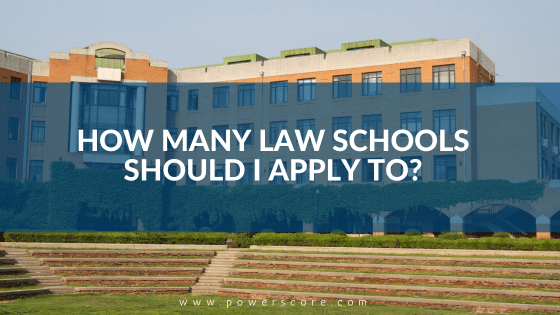If one thing is certain from this blog series, you should expect the answer to be: it depends. There is no perfect number of schools to apply to. I applied to over twenty schools and sat in class next to students who submitted one ED application. Hopefully, this blog will help you determine whether you’re a mass applier (like I was), a targeted applicant (5-10 schools), or an applicant focused on one or a handful of schools. As a general rule, however, if you’re on the fence about a school, just hit submit. More on that below.
Mass Appliers
I submitted dozens of applications and ended up at one singular school. Many hear this and think I wasted thousands of dollars on applications. But, like every case, it is important to consider where I was in the application cycle. My criteria were as follows: I either wanted to go to a T-14 school, mostly agnostic of location, with a decent scholarship, or a T-25 school with a phenomenal scholarship. Every T-14 I was accepted at gave me the opportunity to negotiate scholarships with my preferred T-14. Every T-25 acceptance gave me a chance to negotiate with schools in the region. For instance, a massive scholarship at a T-25 in the Midwest could help move the financial needle with a small scholarship at a T-14 in the Midwest if your commitment to the area is evident. I didn’t look at each additional application as a $130 burden; I saw each application as an opportunity to generate tens, if not hundreds, of thousands in additional scholarship awards.
For what it’s worth, every school I was accepted at granted me a scholarship except for the one I decided to attend. For more on this decision, look out for a future blog post, “Is My Dream Law School Too Expensive?” But would I do it all over again? Absolutely. Applying to an abundance of schools provided the most possible opportunities for negotiation and decision-making.
Targeted Applicants
You may currently fall in this category, though I believe many students don’t submit enough applications. If you want to be in a specific location, it seems sensible to apply to a few safeties (schools you’re above both medians), targets (schools you’re at one or both medians), and reaches (schools you’re below both medians) in that region alone. The only time I would limit yourself to this is when (1) you will not attend any law school outside your region and (2) money is of little-to-no concern.
If you do not fall into both of those categories, I highly recommend adding schools with a strategic purpose. What does that look like? First, it involves applying to target schools outside of your region. If your top choice is the #28 school in the country, consider applying to nearly every school within 3-5 spots. Say you get into school #26 and #28: you now can use any scholarship offer from the former to negotiate with the latter (more on that in Dave and Jon’s scholarship podcast episode). At worst, you’ve lost $135; at best, you negotiated thousands in scholarship amount with your top choice.
In addition, applying to more target schools expands your horizon of opportunities in an unpredictable future. Especially at the modal age of law school applicants, life changes very quickly and so do geographic preferences. An acceptance at a school that is comparable (numerically) to your top choice gives you flexibility in a fast-changing world.
So, even if you’re dead set on being in one location, submitting additional applications at target schools can only bolster your outcome.
Focused Applicants
For a small portion of the applicant pool, applying ED to one school (or RD to a few) can be a great decision. We only recommend doing so when (1) the applicant is dead set on a specific school (not just a region) and (2) when finances are no concern whatsoever. A handful of schools have built-in scholarships for ED applicants, but assuming your school does not offer this, you should be fully prepared to pay full price if you apply ED.
At the end of the day, if you know exactly where you want to be and don’t mind paying full price, you’re likely a good candidate for ED. Otherwise, I caution against it.
Reducing Costs and Final Thoughts
If you decide to apply widely, the cost can accumulate quickly. You’ll pay $75-85 per application, plus an additional $45 CAS fee per school. However, communication and being proactive can eliminate many application fees. First, by opting in to LSAC’s Candidate Referral Service (CRS), you elect to share your GPA and LSAT with participating law schools. Schools typically filter by a GPA/LSAT threshold, and will periodically send out application fee waivers to applicants who surpass their numerical test.
In addition, for schools that you don’t automatically receive a fee waiver from, you can always email their admissions committee and politely ask for a fee waiver. Cite the financial burden of applying to law school and request their support with the utmost respect. Combining these two strategies, I ultimately paid application fees for only a couple of the 20+ schools I applied to. Although you’re still required to pay the CAS fee (unless exempted through LSAC), combining these two tactics ease the financial burden of applying to law school dramatically.
The school I ended up at was beyond my “reach” list that I did not entertain applying until they sent me a fee waiver through CRS. I thought, “what’s $45?” with no intention of getting in.
So, if you’re on the fence about a school, or haven’t expanded your search to other schools in your target vicinity, I recommend over-applying rather than under-applying. Generating fee waivers means that the opportunity cost of potentially generating thousands more in scholarship offers is effectively $45. If you can afford it, this is a no-brainer.
Whether you need full scale assistance or suggestions and edits for your draft, our expert consultants can help you create a persuasive and moving personal statement that conveys your story in an unforgettable manner. You can see all our admissions consulting options here: https://www.powerscore.com/lsat/law-school-admissions/packages



Leave a Reply